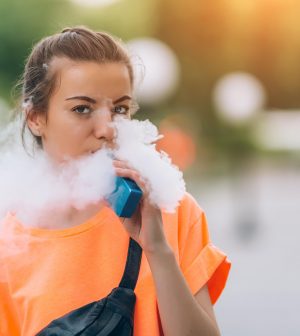- Skip Storing This Everyday Product in the Fridge Door
- Green Tea + B3 Pairing May Boost Brain Health
- Navigating Your Midlife Crisis: Embracing New Possibilities
- City Raccoons Showing Signs of Domestication
- Mapping the Exposome: Science Broadens Focus to Environmental Disease Triggers
- One Week Less on Social Media Linked to Better Mental Health
- Your Brain Changes in Stages as You Age, Study Finds
- Some Suicide Victims Show No Typical Warning Signs, Study Finds
- ByHeart Formula Faces Lawsuits After Babies Sickened With Botulism
- Switch to Vegan Diet Could Cut Your Greenhouse Gas Emissions in Half
The More Kids Use Social Media, The More They’re Likely to Vape

Kids and young adults who use social media for seven or more hours per day have double the risk of taking up vaping or smoking or both, new research shows.
The study is based on a survey of almost 11,000 young British people ages 10 to 25 who were tracked from 2015 through 2021.
Overall, 8.5% said they currently smoked, 2.5% said they vaped and about 1% did both.
How much time they spent on TikTok, Instagram and other social media platforms tracked well with their odds for smoking or vaping, the study found.
Just 2% of people who reported no social media use engaged in cigarette smoking, but that rose to 17% among those who said they were on social media seven-plus hours per day.
Similarly, less than 1% of those who stayed away from social media vaped, compared to 2.5% of those who were using it seven or more hours daily.
Folks glued to social media for seven or more hours a day were also seven times more prone to both smoke and vape, compared to those who spent no time on social media.
The study was led by Dr Anthony Laverty, of Imperial College London School of Public Health, and published May 16 in the BMJ.
Even a little social media time appeared to raise the odds of smoking or vaping. For example, folks who spent 1 to 3 hours on social media daily were 92% more prone to vaping, versus those who eschewed such platforms, the study found.
Laverty’s team stressed, however, that the study wasn’t designed to prove cause-and-effect. However, they noted that vaping and smoking are both promoted heavily on these platforms.
“First, and most straightforwardly, there is evidence that the corporations behind cigarette smoking and vaping make use of social media to advertise and promote their products,” the researchers said in a journal news release.
“This includes direct advertising which is algorithmically targeted and the use of paid social media influencers who present smoking and vaping as a fashionable and desirable activity,” they added. “Greater time spent on social media is likely to increase exposure to these forms of influence.”
There’s also the “reward-seeking” theory: It’s well known that social media can be addictive, in that users constantly chase “likes” and other incentives to stay online. Vaping and smoking, as well, rely on reward-seeking to keep users hooked, the team said.
Then there’s the ‘forbidden fruit’ angle: “As a space that is largely unsupervised by parents/caregivers, social media use may encourage behaviours that are transgressive, including cigarette smoking and vaping,” Laverty’s group said.
They believe it’s time to get tough on social media when it comes to vaping and smoking influencers and the like.
“The companies that own social media platforms have substantial power to modify exposure to material that promotes smoking and vaping if they choose to or are compelled to,” the London team wrote. “Voluntary codes seem unlikely to achieve this, and the introduction and enforcement on bans on material that promote this should be considered.”
More information
Want to quit vaping? The American Heart Association offers tips that could help.
SOURCE: BMJ, news release, May 16, 2024
Source: HealthDay
Copyright © 2025 HealthDay. All rights reserved.










